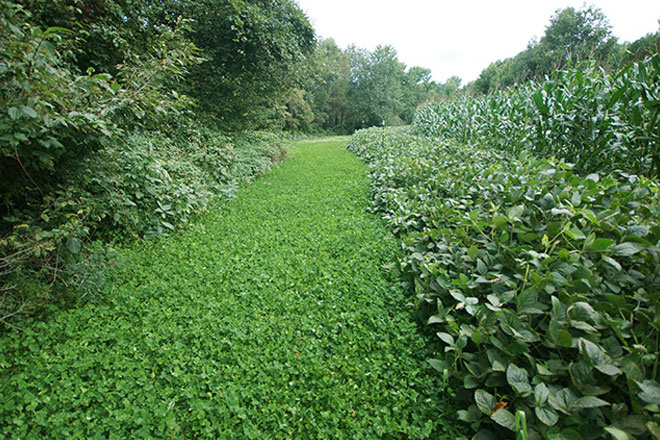Don’t just wear green, plant it
By Charlie Holtz
The shamrock (aka three-leaved clover) is the national symbol of Ireland and Saint Patrick’s Day. Four-leaf clovers are considered lucky, but they aren’t always easy to find (1 in 10,000). Clover is also a popular perennial food plot for deer and brood habitat for turkey, pheasants, quail and other wildlife.
Clovers are legumes and members of the pea family. There are hundreds of different species growing around the world, and not only do wildlife benefit from clovers, but bees love it as well. Many clovers bloom early, making them an ideal pollinator plant to encourage bee activity. Clovers are a great source of nectar and the foliage helps produce large amounts of honey — as much as 500 pounds of honey per clover acre.
There are many benefits of planting clover beyond pollinators and wildlife. Clovers reduce erosion, keep the soil intact and prevent runoff, making them a great choice for buffer strips between fields and along waterways. Many clovers have roots that grow over two feet deep, adding and translocating nutrients and fixing nitrogen. Nitrogen fixing is when plants convert atmospheric nitrogen into a usable form that acts as fertilizer. Once a nitrogen fixing plant such as clover dies, its bacteria is released back into the soil which serves as a fertilizer for other plants.

Clovers are a cheap crop to grow and are a great way to suppress weeds and other non-desirable plants. Since clover is a hardy plant with a dense root structure, it will oftentimes outcompete weeds. This will in turn reduce the amount of herbicides you need to use, saving you both time and money. Clover plots are low maintenance and drought tolerant, making them ideal for lawns. They don’t need fertilizer, they hold moisture and soil, are green most of the year and doesn’t need to be mowed as frequently as turf grass.
A few beneficial clovers for pollinators and wildlife include Alsike clover, Crimson clover, White clover, Arrowleaf clover, Berseem clover and Sweet clovers (yellow and white). Alsike clover, Trifolium hybridum, blooms in spring through summer and is highly regarded by bee keepers for the exceptional honey it helps produce. Crimson clover, Trifolium incarnatum, blooms early in the growing season, providing bees nectar and pollen to produce large amounts of honey paired with other clovers. White clover, Trifolium repens, is a common species seen in lawns that produces white flowers later in the spring into the fall. Arrowleaf clover, Trifolium vesiculosum, is great for grazing, haying and wildlife forage. It can grow up to four feet and has white and pink flowers. Berseem clover, Trifolium alexandrinum, is used commonly as a cover crop, grows up to four feet high, and can tolerate extremely wet but also moderately dry conditions. Yellow sweet clover, Melilotus officinalis, and White sweet clover, Melilotus albus, can tolerate dryer climates and drought more than other clovers and can reach 8 feet tall.
While celebrating St. Patty’s Day, and the onset of spring, consider clover plots for your wildlife and home turf plantings. Many clover varieties can be found in our “
Clover Kandy” food plot mix at
PFHabitatStore.com.
Charlie Holtz is a Western Conservation Specialist with the Pheasants Forever and Quail Forever Seed Team.